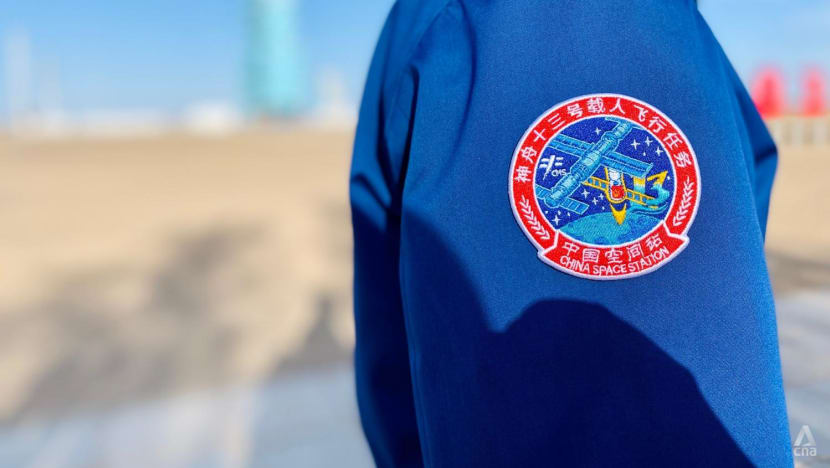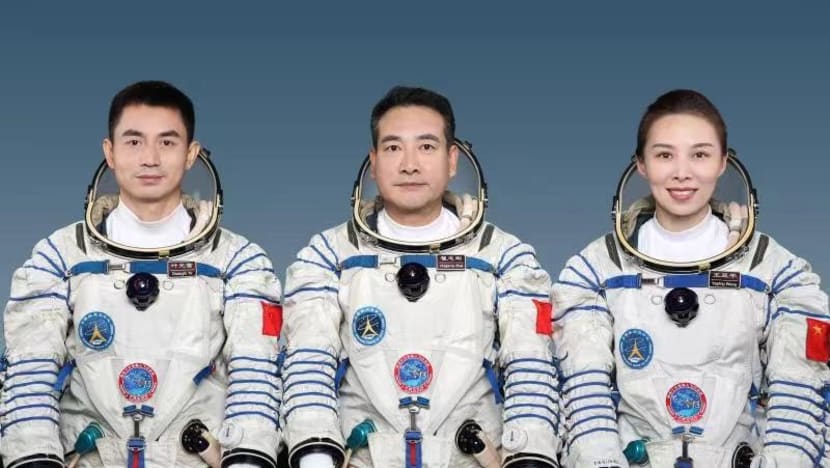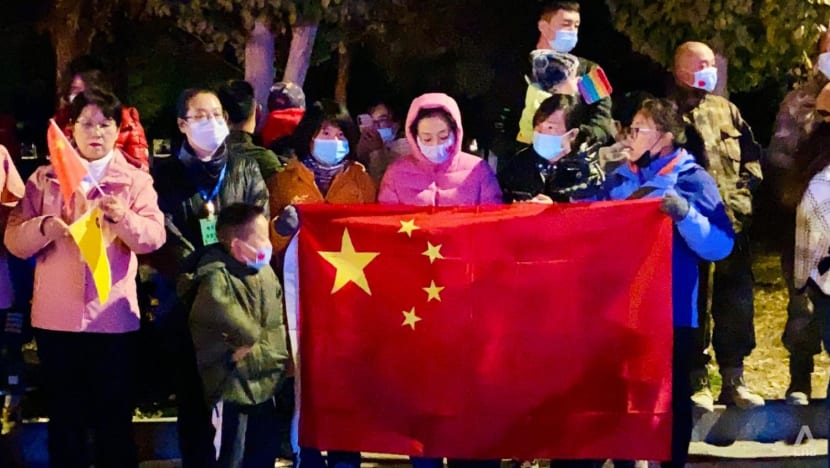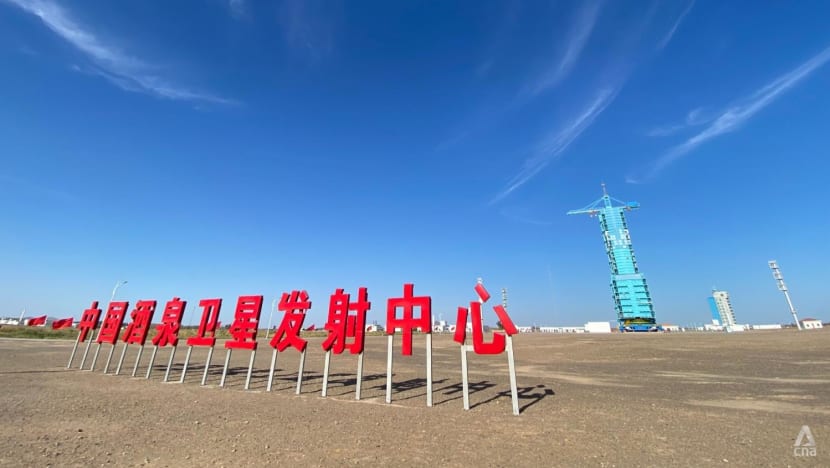Taking flight: The Shenzhou-13 mission and China's space dreams

The mission patch for Shenzhou-13, the spaceflight that carried three Chinese astronauts to the Tiangong space station on Oct 16, 2021. (Photo: Olivia Siong)
JIUQUAN, Gansu: Applause and cheers rang out across a small patch of the frigid Gobi desert when, at precisely 12.23am on Saturday (Oct 16), Shenzhou-13 launched into space.
On board were three astronauts and the hopes and dreams of a billion Chinese people.
More than a kilometre from the launch site, where CNA was positioned, the ground shook from the sheer force of the carrier rocket’s liftoff.
This marked the start of a six-month stay in space for crew members in what is set to be the longest manned mission in Chinese history.
Viewers across the country watched as proceedings were beamed live on state television. The launch was declared a success about 10 minutes later when the spacecraft separated from the rocket and entered its preset orbit.
Six-and-a-half hours later at around 7am local time, the Shenzhou-13 spacecraft successfully reached its destination – docking with China’s Tiangong space station, 400km away from Earth.
BRINGING BACK THE STARS
This is the second group of astronauts China has sent to work on its space station, which is still being built.
Its first component cabin was launched in April and the ambitious project is scheduled for completion by the end of 2022.
Less than three hours before the scheduled liftoff, the three astronauts bid farewell in a customary send-off ceremony at their living quarters in the Jiuquan Satellite Launch Centre.

Much of the attention has been on 41-year-old Wang Yaping, the first female astronaut to be sent to the Chinese space station.
Enthusiastic supporters - ranging from students to those working in the space industry - had gathered hours before, waving flags, flowers and banners, hoping to catch a glimpse of the astronauts taking their last couple of steps on terra firma before half a year of zero gravity.
Among them, Wang’s five-year-old daughter, who was seen calling out and cheering for her mother in a video now making its rounds on Chinese social media.
“She wants me to bring back the stars for her and her classmates,” Wang had been earlier quoted in Chinese state media as saying.
This is Wang's second mission to space. The former military pilot appeared teary-eyed as she departed for the launch tower.
“Whether it is the living space, operating time, or equipment, they are all different (from before),” she told reporters on Thursday.
“As an astronaut, to be able to participate in the construction of the space station, I feel heartfelt pride that our great country is able to create such a great era.”
During Wang’s previous mission in 2013, she gave a live televised physics lesson to 60 million students while in orbit and there are plans this time around for a repeat of that distance learning feat.


A TOUGH TEST
The leader of the trio is veteran Zhai Zhigang, who was described by one of the mission’s chief engineers as “cheerful, humorous and operationally capable”.
The 55-year-old, who is among China’s first batch of astronauts, is also on his second space mission. In 2008, he became the first Chinese to perform a spacewalk.
Thirteen years on, he spoke about the excitement in returning to space but was keen to stress the challenges ahead for him and his team.
“Half a year in flight without gravity is a tough test physically, psychologically and for our equipment, and we are bound to face problems,” Mr Zhai told journalists.
A prolonged period in space is expected to take a toll on the astronauts’ muscles, as well as their cardiovascular system.
“After close to two years of training, the group has come to understand each other and build a rapport. I believe that relying on the team’s strength and wisdom, we will definitely be able to solve any problems,” he said.
Rounding up the crew is Ye Guangfu, who is on his maiden space mission.
The 41-year old former air force pilot reportedly speaks fluent English and is set to play a key role in hosting astronauts from other countries at China’s space station in the future.
Asked to assess the qualities of the Shenzhou-13 group, Huang Weifen - the chief designer of the astronaut system of China’s manned space programme - described the team as “good looking, capable and able to work well together”.
She said more effort has been made to ensure the mental well-being of the crew, who are spending twice the amount of time in space compared to their Shenzhou-12 counterparts. That team returned to Earth a month ago after a 90-day mission.
“Compared to the previous Shenzhou-12 mission, the astronauts will be able to watch more television channels live, listen to music, read books and video call their families on earth,” said Ms Huang.
“We have a very comprehensive support system for the astronauts psychologically, using all means to ensure they can be healthy and efficiently complete their mission.”


SPACE DREAMS
The race to achieve China’s “space dreams” has gathered pace in recent years and officials have frequently linked these ambitions to the national rejuvenation of the country.
China has already sent a rover to Mars and landed a probe on the little-explored far side of the moon.
“There is a lot of scope for space to become more important because I think there's going to be a lot of ways that economic gain is realised through the utilisation of space assets or there's going to be ways that space becomes more strategically important,” said Blaine Curcio, founder of Orbital Gateway Consulting.
“There is also the kind of domestic consumption angle of China having a strong successful space program. It looks good and it makes the country look strong.”
Mr Curcio added there is also a soft power effect.
Related:
China’s space station could soon be the only one in orbit and the only viable option for other countries looking to send their astronauts to such a post for exploratory work.
The International Space Station, which Chinese astronauts are banned from, is due to be retired as early as 2024.
“We welcome astronauts from other countries to enter our space station and conduct international cooperation,” said Lin Xiqiang, the deputy director of the China Manned Space Agency.
“We believe that after construction of the Chinese space station is completed and enters the operational stage, we will see more foreign astronauts visiting our station."
While competition - not least one beyond the boundaries of Earth - with Washington is now inextricably part of the Sino-US relationship, officials maintained China is charting its own path.
“We have our own strategy and our own plan… We do not intend to compare with others,” said Mr Lin.
He added that, based on his own evaluation, US space technology, including manned space technology, is still “among the strongest in the world”.
“If there is cooperation, I think it would be beneficial for both parties,” remarked Mr Lin.
“But if not, we will be able to complete our tasks based on our original plan and with our own technology and capabilities.”














